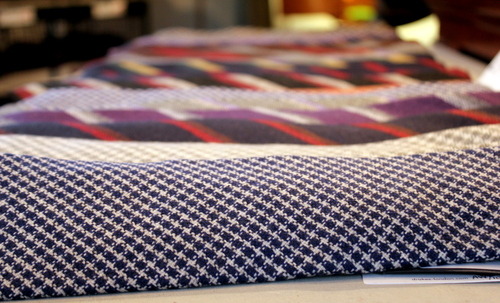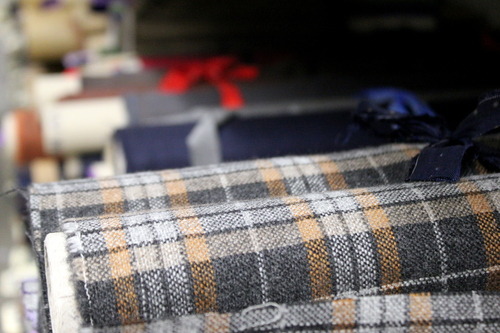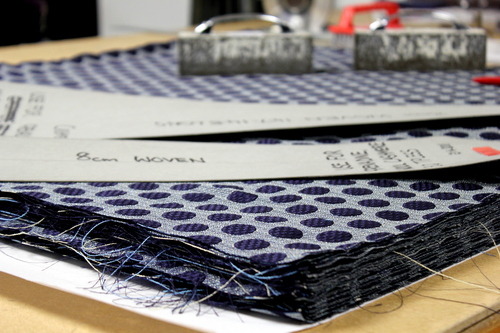At my most recent visit in London I got the chance to visit Drake's London and their new factory & showroom located on Haberdasher Street, in Shoreditch where they moved last February, bringing all their employees under the same roof for the first time ever.
New shop @Haberdasher Street
One and maybe the most interesting part of the new facilities in they eyes of normal consumer is the "factory shop" that was launched this fall at the same premises. At the shop you can basically find bargains from sample items and collections of previous season. There's a full range of ties, pocket square, scarves but as well knitwear, outerwear and even some shoes from previous Drake's collaborations. And it's good to keep in mind that the garments sold in the factory shop are not "seconds" but the same first class quality than any other products Drake's is selling.


Sport coats available at the factory shop
Besides the factory shop I got an opportunity to see all the highly skilled people working and the different phases of making a tie. It was also mind-blowing to take a look not only all the different fabric choices for upcoming lines but also the archives that included tons of different samples from old collections.

Fabrics samples at the archives - from previous collections
In terms of numbers the company at the moment manufactures around 100,000 ties per year, which includes ties made both under their own name and as private label for other well known brands. One important and positive thing is that the new factory facilities have increased the capacity and made it possible at the same time increase the number of ties produced still without compromising quality and craftsmanship of the products. Even though there has been a lot of collaborations with different brands in terms of different garments (such as shoes with Saint Crispin's and workwear jackets with Private White) it's still a fact that ties (together with pocket squares and scarves) remains the core product of Drake's


Range of ties at the shop - wool, cashmere, silk with traditional and more bold patterns.
Next level shirting
It's only couple of weeks now before we're heading again to Florence and Pitti Uomo and Drake's collection for next fall and winter is definitely one of those I'm looking forward to see, not least because of the upcoming introduction of their new line of Drake's shirts. According to Jamie (who also is responsible for running the Drake's tumblr), who was kind enough to give me and my better half a tour at the factory Drake's has recently acquired two traditional British shirt makers that still has production of shirts left in England in the form of Cleeve and Rayner & Sturges . The first one mentioned will in the future supply shirts as Cleeve London exclusively for Drake's whereas the latter will continue manufacturing shirts such as separate brand under Drake's. I will at this point leave the details to be seen but as far as I'm concerned these will definitely keep up with the standards Drake's is operating with all their doing.


At the showroom I had the chance once again to take a look at samples from the upcoming S/S ´14 collection.
Making of a Drake's tie

"Our ties are cut by hand from generous blocks of the finest silks, using a different set of patterns for each quality of silk. The generous blocks allow all three parts of the tie to be cut "fully on the bias", and also insure sufficient cloth to create a deep fold at the back of the tie so it can be hand slipped more securely."

The three tie parts - the blade, neck, and tail - are first joined together, then depending on the cloth quality one of our three tipping styles (untipped, self-tipped, or plain solid) is applied. After this, the tie is inspected for correct length, precision of the tipping and smoothness of the join. The tie is now ready for the important art of hand slipping.

The artisan slipper carefully folds and pins the interlining into the tipped blade until the correct shape has been achieved. Using one continuous length of silken thread to create the time-honoured classic slip stitch, the slipper joins the tie cloth together with the interlining. It's a delicate operation because the folded back join must be kept in the centre of the tie and the interlining and tie cloth must be carefully taken up by the slip stitch without piercing the surface of the tie. The tie loop, cut from the same cloth block as the tie, is then inserted into the back seam at a precisely measured point and caught by the slip stitch. The interlining edges must be firmly against the cloth but not taut; no wrinkle or tightness must appear.

Leaving a slip knot - the functionally important hallmark of the handmade tie - inside the fold at the tail completes the slipping. The knot's function is to take up the stretch in the silk that occurs during the life of the tie. The tie and the interlining are then as one.

The tie is again inspected, gently hand pressed, and the keeper loop is carefully folded back onto itself and hand sewn at each of its four corners onto the tie. Finally, having undergone 18 separate quality checks during production, the Drake's label is stitched on by hand. The finished tie is now ready to be put into its protective cover and boxed ready for delivery.


Leave a comment